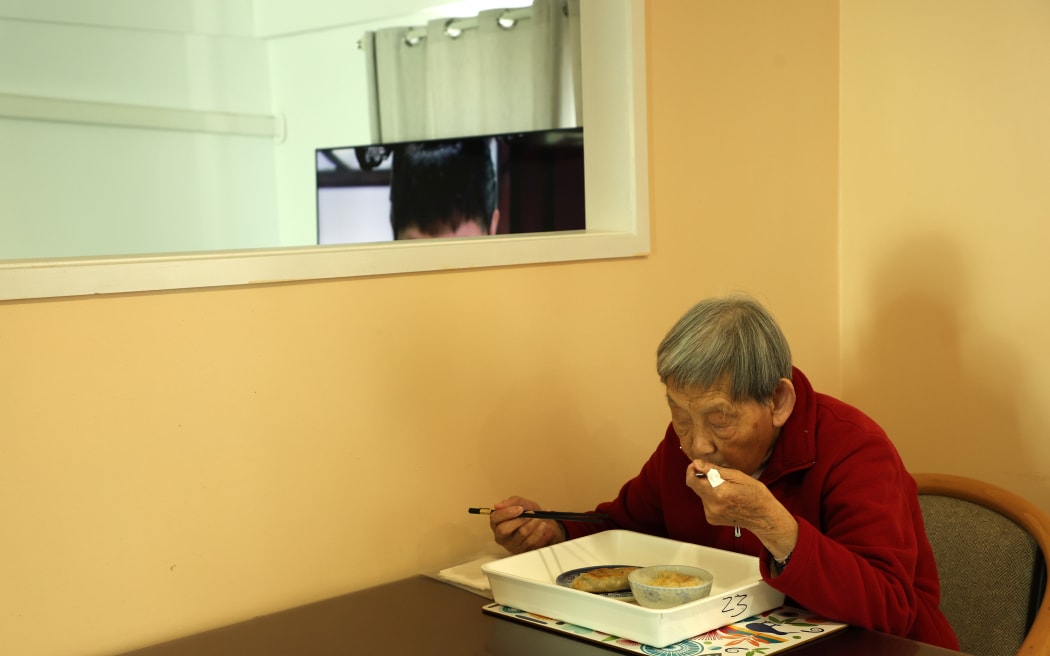How's your aged care set-up looking? Because it can run from a butler and caviar service, to having to trot down the corridor at night to the loo

Photo: RNZ / Yiting Lin
A rest home with a concierge, iced tea fountain, hybrid Jaguars to drive, and caviar on the menu.
That's not imaginary or from some far-flung country - it's reality here in Aotearoa. Oceania Healthcare just officially opened 'The Helier' - a retirement apartment and aged-care complex in the Auckland suburb of St Heliers, described by the company as ''five-star hotel-like'' service.
A different reality at the other end of the aged-care sector, which includes rest homes and specialist private hospitals, is hurting many older Kiwis. Many rest homes are shutting up shop while the sector is staring at a crisis.
BusinessDesk reporter Gregor Thompson has just visited The Helier and had a look at some of the aged care rooms within the complex.
"They've got Alexa built in to them, which means you can voice activate jazz if you see fit, you can ask it what the weather's doing outside. They've got nice TVs, there's 24-hour clinical care that is tailored to each resident's needs, you've got a canapé service, there's a butler, there's a general manager, a French guy, his name is Olivier, not Oliver, so I think that's quite indicative of the type of place that it is."
This is the only private-bed aged care facility in the country, meaning if you get the government-funded residential care subsidy you can't get into these rooms.
At the same time, Thompson is covering the other "extreme".
"You've got small facilities in the regions that are often owner-operated or run by charities and they are experiencing a lot of financial hardship - many of them are closing down."
He gives examples of homes in Foxton Beach, Taumarunui, Levin, Te Awamutu and Rangiora.
A recently released report by Sapere Research, commissioned by Te Whatu Ora/Health New Zealand, has found the sector could be short of 12,000 beds by 2032.
"There's not enough funding to sustain the current aged residential care model," Thompson says.
"In simple terms, the cost to provide care outstrips the residential care subsidy."
The subsidy is paid by Te Whatu Ora to the rest home or hospital and depends on the resident's level of income.
And change isn't imminent - Minister for Seniors Casey Costello told Thompson a Budget bid for extra money probably won't happen until 2025.
Warick Dunn is the deputy chair of the NZ Aged Care Association and chief executive of the Masonic Villages Trust, which runs five aged care homes in the lower North Island.
He tells The Detail most of his homes are "really old".
"We've got homes that were built to a standard that is 45 years old. Many of our rooms are very small, many of our residents have to walk down the corridor to have a shower or even go to the bathroom. They are a very basic offering. The environment is pretty challenging, I would have to say.''
His homes are mostly funded through the subsidy. If the number of beds isn't increased, Dunn says that will lead to older people staying in public hospitals for longer, which will affect everyone who uses those hospitals.
He thinks the solution is as simple as increasing the subsidy.
"We seem to be able to find money when we need to, when there's a crisis, and we are staring at the crisis at the moment. If capacity isn't increased, then the work of Te Whatu Ora in terms of other objectives they have around quick turnarounds in ED [Emergency Departments], access to cancer treatments, access to elective surgery - that will grind to a halt."
You can find out how to listen to and follow The Detail here.
You can also stay up-to-date by liking us on Facebook or following us on Twitter.


